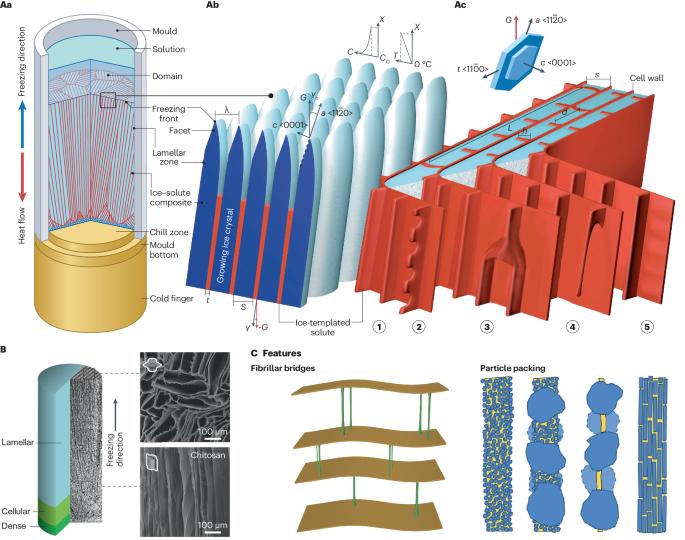Freeze casting
IF 50.1
Q1 MULTIDISCIPLINARY SCIENCES
引用次数: 0
Abstract
When solutions and slurries are directionally solidified, complex dynamics of solvent crystal growth and solvent templating determine the final hierarchical architecture of the freeze-cast material. With continuous X-ray tomoscopy, it is now possible to study in situ intricate and otherwise elusive ice crystal growth and solvent-templating phenomena. Quantifying these phenomena both time-resolved and in three dimensions provides novel insights into the formation of performance-defining features of freeze-cast cellular solids at several length scales: the material’s pore morphology (first hierarchical level), the molecular, fibrillar and particle self-assembly of components in the cell walls (second level) and the cell wall surface structures (third level). The freeze casting process is attractive because the features of the final hierarchical material architecture — which determine the material’s structural, mechanical and physical properties — can be custom designed for a given application. Overall porosity, pore size, geometry, orientation, particle packing in cell walls and cell wall surface features can be tailored for applications in, for example, biomedicine, environmental engineering, catalysis, power conversion, and energy generation and storage. Freeze casting involves directional solidification of solutions or slurries followed by removal of the solid solvent phase. This Primer introduces the freeze casting technique, including experimental and analysis methods, with a particular focus on using X-ray tomoscopy for real-time, 3D observations of freeze casting dynamics.

冷冻铸造
当溶液和浆料定向凝固时,溶剂晶体生长和溶剂模板化的复杂动态决定了冻铸材料的最终层次结构。利用连续 X 射线断层扫描技术,现在可以现场研究错综复杂、难以捉摸的冰晶生长和溶剂模板化现象。通过对这些现象进行时间分辨和三维量化,可以在多个长度尺度上对冷冻铸造细胞固体的性能定义特征的形成提供新的见解:材料的孔隙形态(第一个层次),细胞壁中分子、纤维和颗粒成分的自组装(第二个层次)以及细胞壁表面结构(第三个层次)。冷冻铸造工艺之所以具有吸引力,是因为最终分层材料结构的特征--这些特征决定了材料的结构、机械和物理特性--可以针对特定应用进行定制设计。整体孔隙率、孔隙大小、几何形状、取向、细胞壁中的颗粒堆积以及细胞壁表面特征都可以根据生物医学、环境工程、催化、电力转换以及能源生产和储存等应用进行定制。冷冻铸造涉及溶液或浆料的定向凝固,然后去除固体溶剂相。本入门指南介绍了冷冻铸造技术,包括实验和分析方法,尤其侧重于使用 X 射线断层扫描技术对冷冻铸造动态进行实时三维观察。
本文章由计算机程序翻译,如有差异,请以英文原文为准。
求助全文
约1分钟内获得全文
求助全文

 求助内容:
求助内容: 应助结果提醒方式:
应助结果提醒方式:


